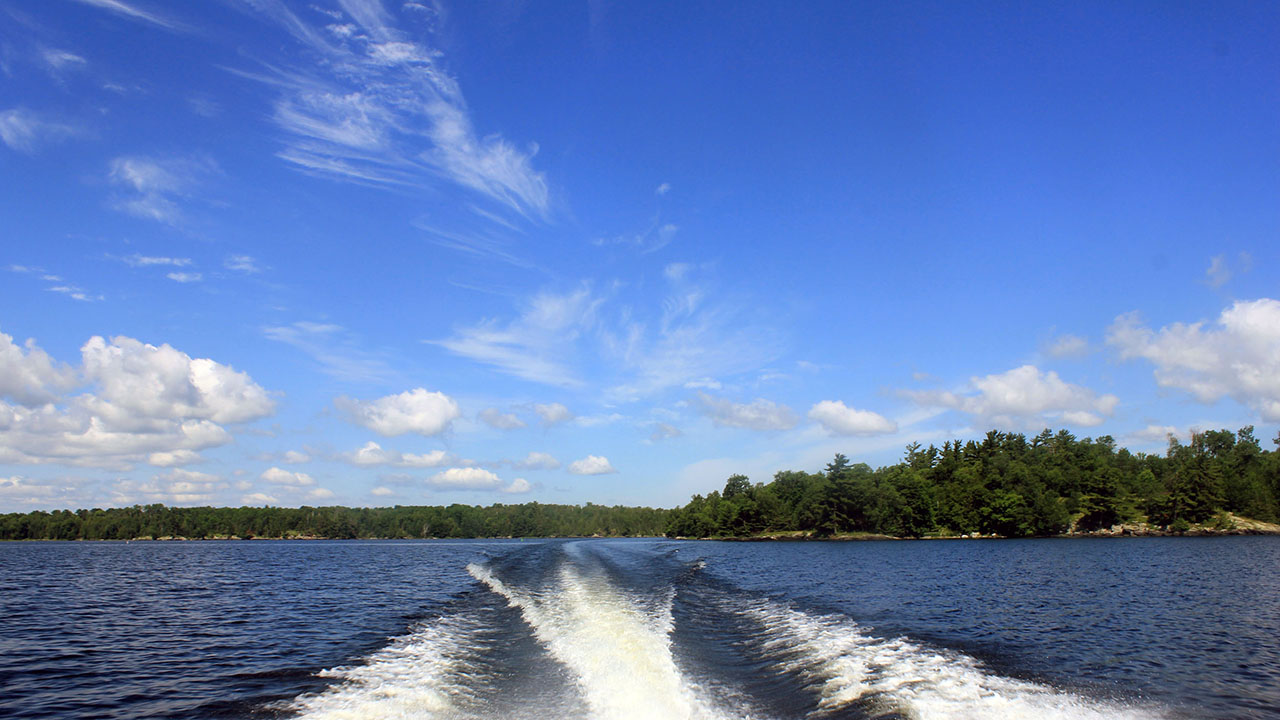
One of Minnesota’s greatest summer treasures are our lakes. The serene morning calls of loons, afternoon family barbecues by the shore, and — best of all — time spent on the water to create those iconic “summer in Minnesota” memories. We dream of it all winter long! And whether you’re gliding behind a boat on waterskis, casting lines for the perfect catch, or simply cruising along the shoreline, boating on Minnesota lakes represents our state’s spirit at its finest.
In recent years, more Minnesotans have been exploring the switch to electric boat motors. As battery technology has become increasingly affordable and efficient, traditional gas motors are giving way to electric motors that are much quieter, are easier to maintain, and don’t pollute our state’s air and waterways.
Fresh Energy recently hosted an informative webinar dedicated to electric boats. We brought together a panel of clean transportation experts including Jukka Kukkonen, our clean transportation consultant and founder of Shift2Electric, Anjali Bains, managing director of transportation, and Nick Haeg, senior associate, electric vehicles.
From practical charging solutions to performance tips for lake conditions, our expert panel shared valuable insights to help both current and prospective electric boat owners navigate this exciting transition. Read on to discover why electric boats are making waves across Minnesota’s lakes!
This article has been edited for length and clarity.
Why are electric boats important for Minnesota’s environment?
Anjali: While much of Fresh Energy’s advocacy to-date has focused on personal vehicles and buses – things that drive on the road – our transportation system is made up of on-road vehicles and off-road vehicles like planes and boats that transport people and goods.
Recreational boating is a favorite past time of many Minnesotans given our abundant lakes. In fact, Minnesota has the most boats per capita of any state in the U.S., with approximately 150-175 boats per person!

Lesser known but still part of our water transportation is our shipping activities, particularly up in Duluth and down the Mississippi River. The Port of Duluth is the biggest port by tonnage among the Great Lakes, with an average of 33 million short tons of cargo passing through, the majority of which is iron ore. As the starting point of the Mississippi River, Minnesota also sends cargo down the river to other states like grains, cement, scrap metal, and more via Saint Paul, which is home to the northernmost river terminals on the Mississippi.
While marine vessels comprise a very small slice of our transportation sector climate emissions, we as a state still need to make sure all these emissions are eliminated by 2050.

Nick: Minnesotans love lakes. We also love boats — we have the most boats per capita of any state! It’s important that we transition our boats to run on clean electricity instead of fossil fuels to keep our lakes as clean and enjoyable as possible, not just for us, but for future generations as well. Electric boats are going to be an important part of the path to a cleaner future for our waterways and our air.
What are the main advantages of electric boats?
Jukka: Electric boats are quieter, cleaner, and require less maintenance. Quietness is a major advantage — it’s a totally different experience to enjoy boating when you don’t have a loud motor drowning out conversation. You can actually talk with your friends much more easily and enjoy nature completely differently.
Electric boats also have significantly lower energy consumption and lower operational costs. You get cleaner air because the boat can run on electricity — which is getting cleaner and cleaner every year — and there are no local emissions. You also have cleaner water; most people don’t realize that with traditional outboard motors, the exhaust gas actually runs through the water after it exits the propeller shaft. Electric boats mean fewer emissions to the air and less pollution directly in the water.
The amount of pollution in our lakes and rivers from gas-powered motors is actually quite shocking. Traditional outboard motors don’t have the same emissions controls that we’re used to with cars — the exhaust is much nastier. With electric motors, you don’t have the emissions or the “rainbow trail” behind your boat.
Electric boats also have much lower maintenance needs than a traditional outboard motor, which means better reliability and ease of use. You don’t have to perform oil changes, change spark plugs, winterize your engine, or deal with a tough-to-start motor. With electric boats, you just go.
Are electric boats more efficient than gas boats?
Jukka: We’ve used internal combustion engines for over 100 years in our cars, boats, and other forms of transportation — and they’re all transitioning to run on electric instead, because the technology is simply better. Internal combustion engines just aren’t very efficient; they are only 15-25% efficient due to heat and mechanical losses. By comparison, electric motors have just one moving part — the rotor — and achieve 85-95% efficiency. That makes electric boats four times as efficient as gas boats.
When something is four times more efficient than old technology, people are going to switch to it. No question about it. It’s similar to how LED lighting has replaced incandescent bulbs. The transition just takes longer with boats because they represent a bigger investment — but it’s one that people will immediately like once they’re out on the lake.
Additionally, newer boats are using hydrofoil technology to lift the boat out of the water, dropping energy consumption by 80% and providing a smoother ride in choppy water.
What’s happening with electric boat technology today?
Jukka: Five to seven years ago, there were very few electric motors available — just a couple different manufacturers had options. But this market is taking off rapidly, with many more manufacturers bringing new motors to the marketplace every year, driving down costs and giving consumers more choice. We’re at a similar point with electric watercraft as we were with electric cars abouts 10 years ago. Where there weren’t many EVs 10 years ago, now there are over 100 models available.
Battery technology has improved dramatically. More boat-specific batteries are becoming available, from small units to larger ones for bigger conversions. As an example, I’ve seen new electric boat batteries with double the capacity for half the cost of what was on the market two years ago — literally twice as good for half the price.
What are the different types of electric boats available today, from small recreational boats to commercial vessels?
Jukka: For recreational boats, there are a variety of motors and batteries available that people can use as a replacement for their old internal combustion engine (ICE) outboard motor. The smallest ones are the electric trolling motors that are commonly used nowadays, especially by those fishing in lakes and rivers. Next, there are compact 500-1,500W (watt) outboard motors that have an integrated, but removable, lithium-ion battery. These are easily portable, and you can use them in any smaller boat or dinghy. I have used one of these for five years now and have been very happy with it. Next in line are 3-10kW (kilowatt) outboard motors that use separate 48V (volt) lithium-ion batteries. These can replace 5-15hp (horsepower) ICE outboard motors.
Two years ago, I converted a 50-year-old retro fiberglass boat to electric by replacing the ICE outboard with a 6kW outboard motor and a 5kWh (kilowatt-hour) lithium-ion battery. I love the results and have been using that boat a lot during my summer vacations. Most pontoon boats also make excellent candidates for electrification because they are used for leisurely cruising around the lakes and often have some space for solar canopies. In addition, there are larger recreational boats and specialized watercraft like electric jet skis coming from different manufacturers, so the number of available options is increasing quickly.
What are the practical considerations for electric boats power and range? What’s involved in converting an existing gas boat to electric?
Jukka: When considering electric boat power and range, owners need to balance their required power level (in kilowatts) with battery capacity and runtime expectations. (Note: one kilowatt is equal to about 1.34 horsepower.) My converted boat with a six kw motor and five kilowatt-hour battery pack can run for about eight hours at a cruising speed of 700 watts, or just under an hour at full power.
The relationship between voltage and amperage is important when selecting components, as this affects cable thickness requirements. For continuous power usage, I recommend staying around a one C rate (where the power used is roughly equal to the battery capacity) to maintain performance.
For boat conversions, there are several things to keep in mind. First, figure out the required power level in kilowatts for your intended use. Then select the right wiring gauge based on your voltage and amperage needs, as well as runtime requirements for proper battery capacity. Then, select a charger with adequate power to recharge your boat batteries over a period of time that works for you.
How do you approach electric boat charging, and what infrastructure is needed?
Jukka: You can use a standard, normal outlet to charge your recreational boat. Mine charges overnight using this method. Many marinas already have normal outlets available, and then there are also higher-amperage outlets available on their docks if you’d like to charge your boat faster as long as your charger and wiring are properly sized for it.
I’ve had people ask me about the cost of electricity to power my boat. I did a calculation and found that if I drain my boat’s battery all the way down to zero every single day for a month, it would cost around $20 total for the electricity, which is quite a bit cheaper than buying gas for your boat.
For larger vessels with higher power needs, the boats can actually use the same charging infrastructure that electric vehicles use, which allows the marine industry to leverage advancements in EV technology for charging electric boats.
Isak: As Jukka mentioned, this is just the beginning of the transition to electric boats, and I’m already inspired to start looking at converting my boat I use a few times a year. If you’d like to learn more about electric boats, transportation emissions, and how to buy or convert your own electric boat, be sure to watch the full webinar to get more details.

